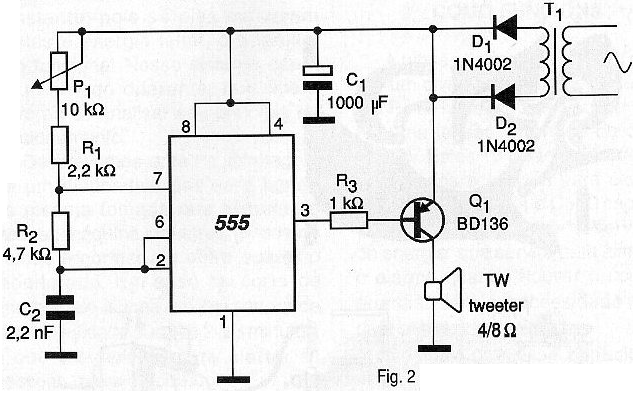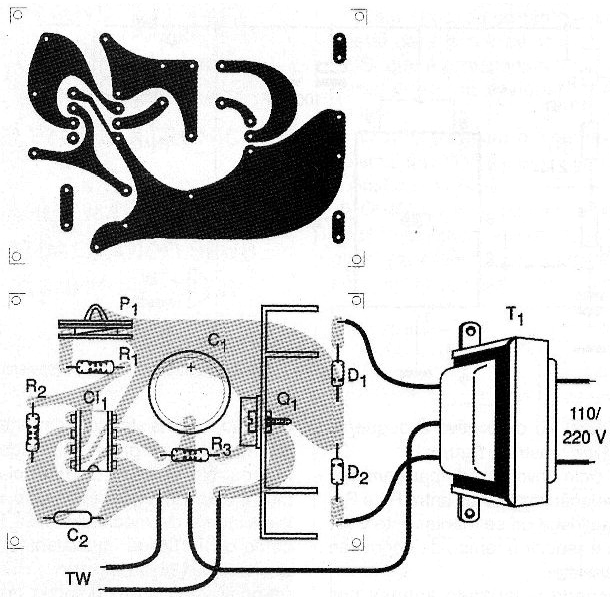Animals such as mice, rats, and even small birds are disturbed by the emission of ultrasonic signals of good power.
In many countries, and even ours, ultrasonic repellents are installed in silos to keep these animals away. See the ads in the agricultural books of the main newspapers to prove this.
The simple circuit we describe serves for small environments and can be installed in a pantry, food closet or even in a place where some type of cereal or product can be attacked by rodents. Placed next to garbage cans it can also help keep stray dogs and cats away, preventing dirt from spilling or even breaking plastic bags.
The circuit produces a signal of good power in the range of 18 kHz to 25 kHz and can be kept on permanently since it is powered by the power grid.
The power consumption will be between 2 and 5 watts depending on the transformer used and the efficiency in the emission of ultrasound is excellent thanks to the use of a piezoelectric tweeter.
CHARACTERISTICS:
• supply voltage: 110/220 V
• operating frequency: 18 kHz to 25 kHz
• output power: 2 to 5 W
HOW IT WORKS
An integrated circuit 555 is connected in the astable configuration producing a signal whose active cycle is small, as shown in figure 1.

The active cycle is basically given by the ratio of values between R1 and R2 and the purpose of keeping this value low is to reduce the conduction time of the transistor.
Staying polarized only in the intervals in which the pulse has a shorter duration, the transistor consumes less energy and thus heats less. However, peak power is maintained.
We can then use medium power PNP transistors such as BD136 or equivalents such as BD138 or even BD140, which must be equipped with a small heat radiator.
The transistor signals are applied directly to a high-performance piezoelectric tweeter.
Although most of these tweeters are indicated to produce sounds in the range of 12 to 18 kHz, many of them have a good response in frequencies that go beyond 18 kHz, that is, above the range audible by humans already in the ultrasound range. So we can use them as inexpensive ultrasonic transducers as long as the frequency doesn't go far beyond 22 kHz.
The circuit is supplied by a 12 V transformer with a current of 500 mA without the need for regulation. Diodes D1 and D2 rectify the low voltage of the transformer secondary, while capacitor C1 does the filtering.
ASSEMBLY
In figure 2 we have the complete diagram of the Ultrasonic Repellent.

The arrangement of the components on a small printed circuit board is shown in figure 3.

The transformer has a 12 + 12 V secondary with a current between 500 mA and 1 A.
The set fits easily into a small plastic strip whose dimensions are basically determined by the size of the tweeter.
In particular, we recommend piezoelectric tweeters of the "button" type, which are no more than 4 cm in diameter and provide excellent performance in the reproduction of high frequency sounds.
The transistor must have a small heat radiator that is nothing more than a metal plate folded in a "U" shape and fixed with a screw with nut on the component body.
ADJUSTMENT AND USE
To adjust, connect the device to the power supply and adjust P1 until the high-pitched sound disappears (stay above the audible limit).
After that, just install and keep the device connected in places where rodents can attack.
It is important not to keep the appliance turned on in places where there are domestic animals such as dogs, cats and even birds as they may feel very uncomfortable with the signal produced by the repellent.
Use only in places where these animals are not present.
Semiconductors:
CI-1 - 555 - integrated circuit, timer
Q1 - BD136 or equivalent - medium power PNP transistor
D1, D2 - 1N4002 or equivalent - silicon diodes
Resistors: (1/8 W, 5%)
R1 - 2.2 k ohm (red, red, red)
R2 - 4.7 k ohm (yellow, violet, red)
R3 - 1k ohm (brown, black, red)
P1 - 10 k – trimpot
Capacitors:
C1 - 1 000 uF / 25 V - electrolytic
C2 - 2.2 nF or 2.7 nF - ceramic
Several:
T1 - Transformer with primary according to the local and secondary network of 12 + 12 V x 500 mA or more
TW – 4 to 8 ohm - miniature piezoelectric tweeter
Printed circuit board, mounting box, power cable, transistor heat radiator, wires, solder, etc.



